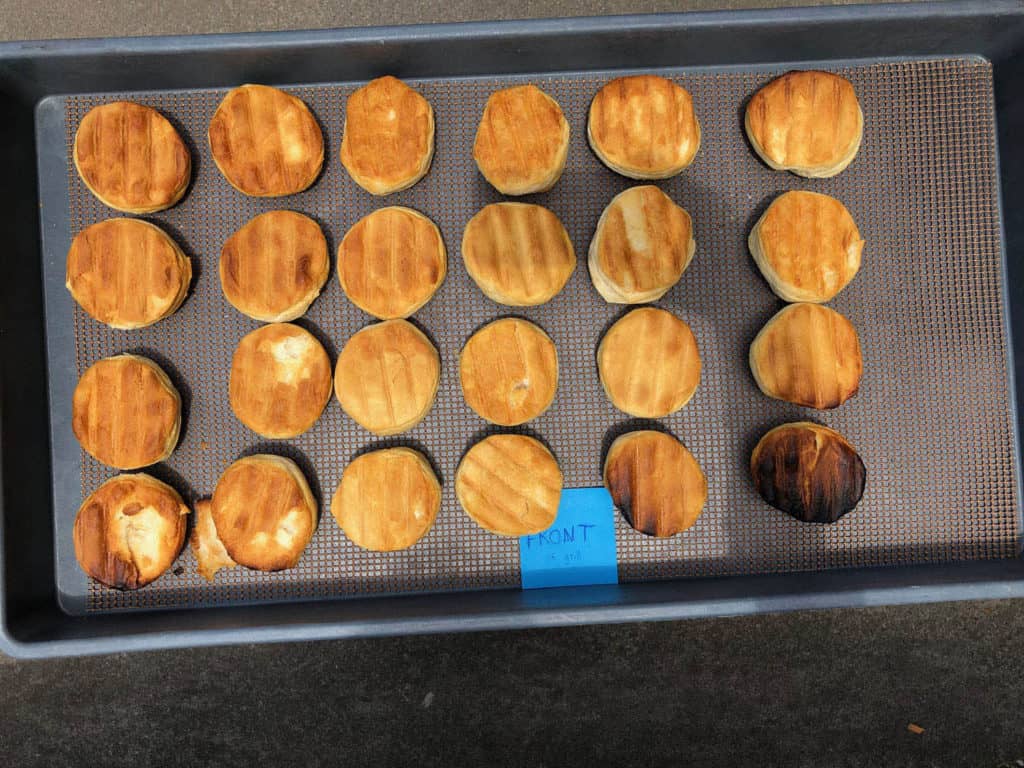The Name of the Game: Good Food, Consistently
Pellet grill reviews are not all created equal. Many don’t give any information other than bullet points about size and that they use an auger to feed pellets. They don’t give any clue as to how easy it will be to cook on. That’s the reason we want a pellet grill, right? So which one is the easiest to cook on? Which gives the most consistent results? Which one has the least problems?

Here’s a secret: they all cook food. And they all cook pretty much the same way: an auger feeds pellets into a firepot at a variable rate, and fans help the combustion process. But the similarities end there. Some grills use cheaper materials in the legs, the lid, the grates. Some have better controllers, wifi capabilities. Some roll better than others. Some vibrate and make noise, while others are solid chunks of unshakeable steel. These are the things you need to know and can’t tell from just pictures.
How to Spot a Cruddy Pellet Grill Review
There are a lot of pellet grill reviews online. Most are garbage. Yes, we said it. There are many sites that do nothing but summarize or copy and paste from online listings, usually Amazon, and call them a “review.” Whoever wrote them most likely has never seen the grill they’re reviewing, much less used it. There’s a good chance, in fact, that they have never used ANY pellet grill.
Here are the clues to help identify a garbage review:
- Only uses images from Amazon or manufacturer images (no pics taken)
- Language is garbled or nonsensical or not pertinent to owning a grill
- Highlights aren’t important to a decision. For example: “this grill uses an auger to feed the fuel, which makes temperatures adjustable.” This is a sure sign of someone skimming bullet points, without understanding, and calling it a review
- The review appears to be a comparison review, but SURPRISE all the grills reviewed are available on Amazon, with affiliate links! No other grills made the top 10! Crazy!
- No specifics on temperature performance, materials, customer service, appearance. Why? Because they’ve never been in the same room with the grill
How We Test
First, we actually have the grill. We unpack it. Build it. Inspect it closely. We measure the metal thickness. Take pictures. Then we put pellets in it and start it up. We test temperatures with laboratory-grade instruments. We use the controls, the app. We poke around the grill company’s online community, gauge its culture. We make calls to customer service.
In short, we test the grill. Sometimes we don’t have an actual model at our disposal. If this is the case, we’ll let you know. But we’ll still review everything we can: the features, the rumors, the customer feedback.

How many burgers fit on it without burning? 
We measure components for comparison. 
How beefy is that grate?
We score each area we test on a 1-10 scale. Then we compile the scores and average them into an overall score, which we attach to each of our reviews for your comparisons. We think it’s very useful.
Below are the items we test in our process, with a score for each. At the end, we tally up the scores, and write what we think is a solid pellet grill review on which to make a decision.
Our Areas of Review
- Overview
- Basic Features
- Cooking Area
- Controller Type
- Notable Features and Conveniences
- Manufacturer Specs
- Hands-On Testing
- Overall Appearance/Impressions
- Materials Quality (including thicknesses)
- Grill Operations and Controls
- Temperature Performance Measurements
- Ownership Experience
- Customer Service
- Ease of Ownership
- Dependability
- Summary and Overall Rating
Temperature: The Main Thing
In smoking, and with any cooking, the secret ingredients are time and temperature. In a pellet grill, the length of time you cook is entirely up to you. The grill, however, needs to do it’s part and maintain a consistent temperature. And you need to know that what the grill says is indeed true. This is the secret of smoking. Control the time, know the temperature, and everything will be great.
A grill that maintains a temperature well, then, is important. This comes about via several factors:
A controller that controls well
All controllers are NOT created equally. A pellet grill uses its auger to control the feed rate of pellets, and turns fans on and off in order to reach and maintain a target temperature. It does this easily in an empty grill. It gets a bit more complicated when you put a 10 pound chunk of refrigerated meat in it. Add in a January wind or 95 degree July temperatures, direct son, the cooling process of evaporation as food cooks, etc. Now the grill is dealing with several variables.
The more complex PID controllers are constantly learning along the curve of reaching a temperature, constantly measuring and adjusting so that the temperature is hit–not overshot, not undershot–and maintained. More simple controllers have a pre-set programming to get to temperature, whether or not it’s hot or cold outside or if there’s a 15 lb cold turkey inside or just a bagel with some cheese. They don’t learn, they just do. So they may overshoot a temperature. And then adjust down. And then miss the mark. And then adjust upwards. And overshoot. And repeat. This process will keep a temperature around the one you want, but the swings–sometimes 40 or 50 degrees–can affect the cook a bit. It gets the job done, but the results aren’t as predictable.
Accuracy of temperature
The pellet grill tells you what temperature it’s at on its display screen, or you’ve selected it on a rotary dial, or perhaps it’s telling you via an app on your phone. Either way, the accuracy of that report is important. If you need to cook a pork butt at 225, then you need to know it’s 225 in your smoker, and not 255 or 195. So we measure actual temperatures vs reported temperatures. We do this across a range of temperatures, using industrial thermocouples and a data logger.
If a grill, for example, shows 300 degrees to you, but in reality swings between 275 and 340, then we’ll know it. And we’ll rate it accordingly. Your infrared laser thermometer is NOT the same. It only measures one tiny spot at one moment, with the lid open. We want trends. And so we measure accordingly.

We measure components for comparison. 
Logging temperatures 
Each sensor reports back to the datalogger 
Measuring temperatures across the grate 
We look at the quality of components
Consistency of Temperature: The Biscuit Test
Also important is a measure of the evenness of temperature inside the smoker. Hot spots or cool spots need to be known. Even distribution of smoke and hot air is what you want in a smoker. Most perform well here, but we test anyway. So we cook biscuits. These fragile canned biscuits turn golden brown when cooked at proper temps, but char quickly in hot spots. So we use them as a visual indicator of hot and cold spots.
But don’t just take our word for it. The folks at GQue Barbecue did a video to explain the importance and the process.
The Biscuit Test
because biscuits don’t lie

See the hot spots? 
Ownership Experience
We do pellet grill reviews that go beyond the grill itself. We note the hours of availability of a company’s customer service line. Most people grill on nights and weekends. What happens, then, if their support line isn’t available after 6pm or on weekends? We also put in calls, noting how long it takes to talk to a person, how knowledgeable they seem, and in general what a “pain” it is or is not to deal with their support.
For many grills, the support can come from the community of owners. Owners are usually very willing to offer tips and suggestions for issues they’ve faced or known issues. And they’re a great resource for new techniques, new recipes, and general tips for getting the most from your smoker. We look at the size and the level of activity of this community as part of our review.
Another source of information is a grill or a brand’s track record. By scouring the internet for online customer reviews, forum posts, and social media, we can usually get a fair idea of the dependability of a particular grill. We’ll find the common issues, as well as what it took to fix them. This information, combined with a review of a company’s overall reputation for customer service, their construction materials, and their warranty information, will give a fair idea of the dependability of a particular grill.
Our Pellet Grill Reviews are For Your Peace of Mind
Again, the idea is to give you a fair assessment, a bit of peace-of-mind, before you shell out the big bucks for a pellet grill. Your experience will vary, but we just want to point out the specifics of our pellet grill reviews as best we can. Truthfully, most every grill will cook decently well. And in the end, owning any pellet grill is a giant step-up from conventional grilling and is apt to make you the object of admiration by anyone that tastes the food you serve them.
Happy pellet grilling!



